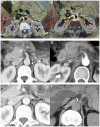Anatomic pathways of peripancreatic fluid draining to mediastinum in recurrent acute pancreatitis: visible human project and CT study
- PMID: 23614005
- PMCID: PMC3629108
- DOI: 10.1371/journal.pone.0062025
Anatomic pathways of peripancreatic fluid draining to mediastinum in recurrent acute pancreatitis: visible human project and CT study
Abstract
Background: In past reports, researchers have seldom attached importance to achievements in transforming digital anatomy to radiological diagnosis. However, investigators have been able to illustrate communication relationships in the retroperitoneal space by drawing potential routes in computerized tomography (CT) images or a virtual anatomical atlas. We established a new imaging anatomy research method for comparisons of the communication relationships of the retroperitoneal space in combination with the Visible Human Project and CT images. Specifically, the anatomic pathways of peripancreatic fluid extension to the mediastinum that may potentially transform into fistulas were studied.
Methods: We explored potential pathways to the mediastinum based on American and Chinese Visible Human Project datasets. These drainage pathways to the mediastinum were confirmed or corrected in CT images of 51 patients with recurrent acute pancreatitis in 2011. We also investigated whether additional routes to the mediastinum were displayed in CT images that were not in Visible Human Project images.
Principal findings: All hypothesized routes to the mediastinum displayed in Visible Human Project images, except for routes from the retromesenteric plane to the bilateral retrorenal plane across the bilateral fascial trifurcation and further to the retrocrural space via the aortic hiatus, were confirmed in CT images. In addition, route 13 via the narrow space between the left costal and crural diaphragm into the retrocrural space was demonstrated for the first time in CT images.
Conclusion: This type of exploration model related to imaging anatomy may be used to support research on the communication relationships of abdominal spaces, mediastinal spaces, cervical fascial spaces and other areas of the body.
Conflict of interest statement
Figures





References
-
- Zhang SX, Heng PA, Liu ZJ (2006) Chinese visible human project. Clin Anat 19: 204–215. - PubMed
-
- Spitzer VM (1995) The Visible Human Project. Available: http://www.nlm.nih.gov/research/visible/visible_human.html via the Internet. Accessed 11 Sep 2003.
-
- Lee SL, Ku YM, Rha SE (2010) Comprehensive reviews of the interfascial plane of the retroperitoneum: normal anatomy and pathologic entities. Emerg Radiol 17: 3–11. - PubMed
Publication types
MeSH terms
LinkOut - more resources
Full Text Sources
Other Literature Sources
Medical
Miscellaneous

